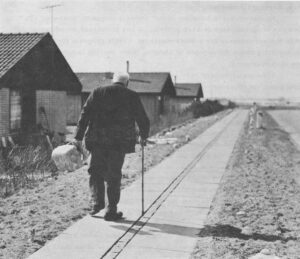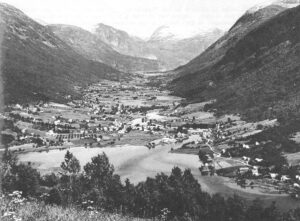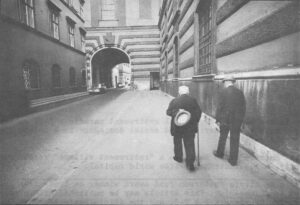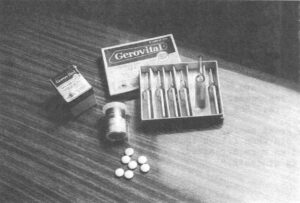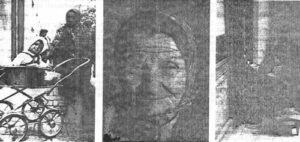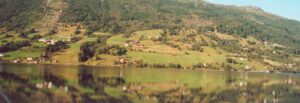The Post and Courier
Charleston, South Carolina
Sunday, December 30, 2001
ARTS & TRAVEL, front page
Sometimes you need to see a place from a different perspective to better appreciate its history and culture. That is true of Charleston as you glimpse the story-rich shoreline from a Fort Sumter tour boat.
That is even truer of Norway, all twelve hundred craggy miles of coast walled by barren cliffs and glaciers that plunge into the North Sea. Subsistence patches of scrub forced Vikings as early as 800 A.D. to go “aviking.” The Norse verb for exploring propelled them, bravely, into uncharted waters and the determined conquest of five rich continents.
Late summer, my husband, Bill, and I made comparatively luxurious explorations via the Norwegian Coastal Voyage’s new “MS Richard With.” We had flown from Oslo to board the ship in northern-most Kirkenes. Then we sailed south, a five-day odyssey that led to the port of Maloy and further adventure.
Our extended wanderings began when we docked near the tip of the globe and took a bus to the edge of North Cape. The coordinates – 71 degrees, 10 minutes, 21 seconds – are indelible on souvenirs and my memory. Brochures promised a spectacular vista over the Arctic Ocean. But outside in the surging wind and dense fog, I barely saw the barbed-wire enclosure four-feet away as I steadied myself on steel bars.
North Cape is part of the treeless tundra of Finnmark province, the “umbrella” of Norway that covers parts of Sweden and Finland as well.
Returning toward the ship, our bus paused in the middle of a bleak plateau for a contrived photo op. Working out of several tents, two costumed Samis posed with one reindeer and sold reindeer-bone geegaws. Proof, I guess, that the Norwegian government, which seasonally ships in the small colony and herds for summer pasturing, takes care of the former Lapp minority.
Back on board ship, we pass alongside miles of raw, oft majestic beauty, a continuous glacial cityscape that startles the eye. Each zigzag of the coast reveals contemporary architectural shapes, so many ice palaces that sparkle like uncut diamonds. Less glamorous neighbors are muscled, brown pyramids glistening like baroque pearls as they shed capes of winter snow. Pillowed on aquamarine and sapphire-hued seas, while whales cavort, the outlines stand imperious against blue velvet sky.
By nightfall, nearing midnight we bask in the afterglow of the summer solstice. A grand stage curtain of orange, red, and magenta descends on a glorious, pacific day. And in the profound silence, atop thick, firm cabin mattresses, we enjoy lovely sleep.
Each day brings sun, few raindrops, little cold weather, and many smiles. Some say ours is the best voyage in years and beats the storm-driven northbound leg.
This is day four of our journey southward and we have yet to cross the Arctic Circle. When we do, on schedule per pre-printed timetable, we toast fellow passengers “Skol” with spiced wine. The captain congratulates each of us with a firm handshake and extends signed certificates.
That would be the first and only glimpse of the ship’s master whose palpable skills steered us into and out of tiny Trollfjord. He turned the high-tech vessel 360 degrees, manually, to dear a fjord barely wider than the ship’s length. (For the record there are also female captains on the Norwegian line.)
More exquisite seamanship followed in another part of Circe’s northern playground, a reference to Homer’s mythological sorceress. Watching from top deck one morning, we wove in and out of ragged coves, frying to avoid banking into mountain-topped islets like some daffy game of pinballs.
During the five-night voyage, we stopped at many ports, large and small, ours a working vessel on exading schedule, picking up or dropping off passengers and cargo by design.
Thankfully, this was no cruise ship and required neither casino nor stage shows nor midnight buffets to burnish the mission or the effect. We enjoyed gracious public rooms, comfortable cabins, erudite commentaries on coastal highlights, sociable Norwegians and seafood buffets that would surpass expectations of the most demanding gourmet.
Of the several land excursions, my favorite was the millenium-old city of Trondheim. The venerable cathedral – pale stone walls and flooring in part slicked black by one-time pilgrims – is also the final resting place of Norwegian kings.
More sobering en route were the World War LI monuments in Finnmark, a province the size of Delaware, scourged by departing Nazis. Little was rebuilt and only one wooden church remains.
We passed dozens of ports where fishing, the mainstay for centuries, flourishes with state-of-the art gear, processing plants and fish farms. Other paraphernalia heralds the ’70s oil boom that makes Norway one of the world’s wealthiest nations.
Predawn, foreshortening the usual Bergen termination point Bill and I disembark at Maloy, entrance to the Nordfjord. We huddle in the empty passenger building waiting for the first bus to Stryn, aka. Shangri-la.
That’s how I remember a special community visited on a ’70s Alicia Patterson fellowship to study old age. I was so impressed then with the ageless, vital and loving neighbors hewing to ages-old rural social codes that I titled the essay “Where They Live Forever.” In a way, 30 years later, they still do, rarely slowing down because of chronological age.
Friends from that era greeted us, meeting Bill for the first time. All were healthy, lean and fit befitting an almost genetic bent for running, skiing, walking, and latter day aerobics.
We revisited haunts from my “Heidi-in-the-Fjords” days that have become tourist meccas for hiking, skiing, fishing and boating. First Briksdal, the largest glacier in Europe with its pink-marble-like pathways.
Then mountain-top villages such as Egge, or Sandal which rents holiday cottages for seasonal skiing or walking. And finally the world-renouned salmon fishing site, the Stryn River.
While in the Nordfjord, we stayed at the five-stat Hotel Alexandra in nearby Loen. Favored by British steamer travelers since the early 19th century, including Queen Alexandra for whom it was named, the luxe, updated hostelry is a magnet for newcomers by land or by sea – as the plethora of cruise ships attest.
One day, Bill and I took a three-hour bus ride to the Sognefjord’s brilliant Norsk BreMuseum (glacier museum) that opened in 1991. Despite the jolt of switchback roads and the onset of four days of dulling rain, nothing could dim this jewel designed by Norwegian architect-laureate Sverre Fehn. The concrete, space-age structure angles in salute to Jostedalsbreen, the glacier that reigns above it.
A tour of the museum starts with a dramatic five-screen documentary, conceived by museum director Nils Paulsen. The film sets the stage for numerous hands-on exhibits and dioramas that tell the fascinating story of glaciers, and augmented by a huge display of ages-old ice, chipped daily from Jostedalsbreen itself.
In the rain, which doesn’t let up, we ride toward the eponymous glacier as cows, self-directing toward pasture, trudge alongside the road.
Once there, I was unprepared for being so close to the receding frozen cascade spilling near my feet. The Arctic gusts chilled my face as though I were in a huge freezer. Cold and wet, we sought refuge plus hot soup and cocoa in the adjacent cafeteria building.
I was surprised to learn that nearby Fjaerland on the Sognefjord is a popular book town (website: www.Booktown.net). Cari and Claus Kvamine, retired educators, stock 150,000 international titles in two shops, and another 400 on a free-standing, road-side rack labeled “Honesty Book Shop.” The equivalent of $1.00 dropped into the attached coin box that day could have bought “Future Shock.”
Book Night in late June is the big annual event with 40 purveyors setting up shop until 2:00 a.m, thanks to the midnight sun. Probably worth an overnight stay given the old-fashioned retreat of visiting royals, the Mundal Hotel located across the street.
The rest of Sognefjord was a haze of freezing rain, only redeemed in the folksy sophistication of Bergen. Arriving by catamaran, we squeezed a commendable city tour into several dry hours – first to a reconstructed stave church (the graceful, carved wooden churches of old Norway), then to the summer villa of composer Edvard Grieg. The last perched on a lakeside idyll, has an adjoining concert hail where we, alas, just missed a piano recital of Grieg compositions.
Another downpour, a torrent that pulled umbrellas inside-out and blew away my prized Norway cap, scotched the pleasures of Bergen’s famous dockside fish and flower market. Before gales knocked over both persons and canopies, I bought gift tubes of three types of inexpensive Norwegian caviar. They were part of every hotel breakfast buffet and admittedly addictive.
Bill’s own rather witty purchases, reserved as Christmas stocking stuffers, included several sealed, yet sloshing, sardine tins labeled “Bergen Rain.” As if we could forget.
But all was not lost. We concluded our Norway sojourn with an insurance policy, of sorts, against capricious weather and a dearth of vistas. “Norway in a Nutshell” is a packaged 12-hour excursion via bus, fjord steamer, and trains from Bergen to Oslo or return. Impressive indeed, and especially the Ham electric railway that inches up a steep incline – 55 degree gradient – and stops at a mini Niagara Falls where you actually feel the spray.
We had a good day of sunshine, marvelous scenery, and last-minute shopping opportunities at train depot outlets. I hankered for one of those Norwegian ethnic patterned wool sweaters, but thought the better of it for warm Charleston winters. By late evening, we arrived at the Oslo train station and walked across the street to our hotel. Our baggage met us there, having been sent ahead from the Bergen train station. Oslo as you may have guessed, was our initial SAS- airline port of entry, and now, departure.
I mention SAS because its service was an amazing throwback to the early days of economy travel: good food, and smiling, attentive staff.
For the rest, Oslo offers many excellent museums, our decided passion. A city tour encompasses the Viking Ships Museum where beautifully preserved vessels and artifacts are a tease for further study.
There is also the Vigeland Sculpture Park with towering “family-of-man” statues arranged in various daily activities and professions.
Yes, it rained again. But by now you’ve guessed that we are not big-city types. Not with all those Fjords beckoning.
Getting There
General Information Scandinavian Tourist Board tel. (212) 885-9700; website: goscandinavia.com
Request Norway tourist information. NB The Norway desk is exceptionally helpful; extensive brochure mailings include hotel info. Our moderate price accommodations included: Oslo: Rainbow Hotel Europa (good airport-bus drop off);
Clarion Royal Christiania (across from Oslo RR for “Nutshell” return)
Bergen: Hotel Hordaheimen
Norwegian Coastal Voyage Inc. Bergen Line Services tel. (800) 323-7436
website: www.coastalvoyage.com
Year-round 6 or 7 day northbound / southbound voyages; 12-day round trip excursions; airfare induded; senior discount. An excellent value for the cost.
Stryn & Nordfjord Tourist Information: e-mail: mail@nordfjord..no
Hotel Alexandra, Loen, Nordfjord: e-mail: alex@alexandra.no; website: www.alexandra.no

